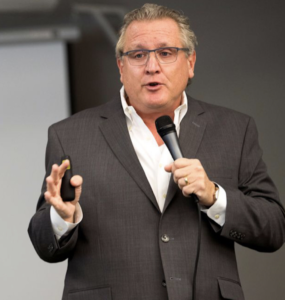
Ed Keller is one of my marketing heroes. He’s considered the godfather and preeminent authority on word-of-mouth marketing and he wrote the seminal book on the subject in 2003, The Influentials. Ed is still researching the subject today as a professor at the University of Pennsylvania.
To illustrate my Ed Keller fanboy level, I used to drop by his office whenever I taught at Rutgers University just for a chance to meet him. I never did. So what a thrill when one day Ed reached out to connect to me on LinkedIn!
Since then, we have collaborated in a few ways, including a conversation within my RISE marketing community.
Word-of-mouth marketing has never been more relevant and never less understood. If this is a new idea to you, this article on the difference between influencer marketing and word of mouth might be a great place to start.
So let’s get to Ed. Here are a few excerpts from my conversation with him and how word-of-mouth marketing is especially relevant in the digital age. These are quotes from Ed, which have been edited for brevity:
What is an influential?

Ed Keller
For a long time, we have had a misconception about how influence works. These are certain people — about 10 percent of the population — who are interested in acquiring knowledge, keeping up with things that are new. They like to talk to people about what they learn. As they acquire this new information, the process gets turned around, and they get sought out for their advice since they seek so much knowledge.
So it’s not any kind of pushy influence like you would want to avoid. An influential is actually someone you’d like to run toward as a trusted friend. We live in a complicated world, and it is a complicated consumer marketplace. We need somebody to make sense of it for us. That is the role of the influential and word-of-mouth marketing, as it has been throughout history, and especially now in the digital age.
Trust in traditional institutions has plummeted. And that doesn’t just count for trust in advertising. It’s trust in corporations, government, and media.
And so more and more often, these influential people play the essential role of trusted advisors in our own social circles. We rely on them to make sense of complexity.
The science behind word-of-mouth marketing
The research shows that across cultures, roughly one in 10 people are influentials. There’s not like a hard statistical cliff there. There’s sort of an influence continuum. But for research purposes, we had to establish criteria to show that either you’re an influential or you’re not. We looked at three things:
Knowledge base — In order to be influential, you have got to know your stuff. You’re not going to be influential if your head is in the sand and you don’t know what’s going on around you. So we came up with a battery of tests that allowed us to identify people who keep up with things that are new across a range of different categories, everything from politics to cars and technology to travel and financial services, etc.
Authority — We would not ask people, “Are you influential?” but we do ask people, “Do you tend to get sought out for your advice and recommendations?” This is an indication of trust and authority that leads to influence.
Network — Finally, in order to be influential, you have to have a fairly wide social circle. I can keep up with things that are new, but if I just keep talking to the same small group of people over and over again, I’m not going to spread things widely into the population as a whole. So we also looked for people who have a fairly wide social circle. This has another advantage. The wider the circle, the more new things influential will learn along the way.
From that, we developed a zero to 100 scale of word-of-mouth influence. Then we really studied the top 10 percent. Who are they? What makes them tick?
Word-of-mouth marketing in the digital age
The foundational research was done through surveys. Now in the digital age, we can also study a person’s social graph.
Obviously, a person like Kim Kardashian has a massive number of active followers. That counts for a lot on social media. But the pendulum has swung toward more narrow influencers if you will, people who have a smaller number of followers, and a lot of that has to do with this issue of trust.
If you’re an influential because someone’s paid you to hawk a product, you’re really just the paid commercial spokesperson — you haven’t earned that. On the other hand, if you’re known and you’re publishing content, then you’ve earned a following. Then you can be very influential and maybe build a community. You can certainly earn the right to be influential.
During the pandemic, people were not physically gathering face to face for a lot of word-of-mouth engagement.
Despite the rise in social media, a huge number of people still engage in word of mouth offline in live interactions, but also in texting, Zoom chats, and so on. You don’t see it by scraping social media sites.
Online versus offline
One of the most important things that my colleagues and I learned is that social media is not a mirror of offline word of mouth. If you follow social media trends, you’re not looking at the things that the average American is also talking about. In fact, we won some awards by demonstrating that there’s no correlation in the trends between what gets talked about offline and what gets talked about online.
The question is, how could that be, and why not? The short answer is that everybody, for the most part, engages in offline word of mouth — we all talk every day with people about new products, ideas, what to watch on television, etc.
But something like 6% of people are posting 80% of the content. So what you see on social media is fairly concentrated. The other thing is something my academic friends call social signaling. If I post on social media, I’ve just been to a hot restaurant. I’ve just been on a great place on vacation. It reflects well on me. The rest of my life … well, I’m just not choosing to put on social media.
On the other hand, if we’re face to face and having dinner together, then we’re going to talk about a whole lot of things, some of which will be earth-shattering and other stuff that is mundane — but nonetheless important.
So no correlation between the two, and yet each contributes about equally to sales and brand health.
The analogy that I like to use is rowing. If you row with one arm, you’ll go in circles. If you’re rowing with two arms, you’ll get to where you want to go. To understand the world in marketing, you need to consider both online and offline conversations
Impact of COVID on word of mouth marketing
During COVID, so much of our life got thrown into upheaval that the volume of word of mouth offline, increased, not decreased. People had new things they needed to talk about; they were trying to work their way through things that were very difficult, very complicated. Nothing was familiar anymore.
People found new ways to communicate with others, even if it was over Facetime or Zoom. We’re coming back down to Earth on some of those technology-driven solutions and people are looking for ways to experience things out in the real world again, but both ways of connecting remain important. So we had an expectation that everything was going to be different in terms of word of mouth. And it turns out that it’s an important force, and it continued to be quite important to people during and after COVID.
 Mark Schaefer is the executive director of Schaefer Marketing Solutions. He is the author of some of the world’s bestselling marketing books and is an acclaimed keynote speaker, college educator, and business consultant. The Marketing Companion podcast is among the top business podcasts in the world. Contact Mark to have him speak at your company event or conference soon.
Mark Schaefer is the executive director of Schaefer Marketing Solutions. He is the author of some of the world’s bestselling marketing books and is an acclaimed keynote speaker, college educator, and business consultant. The Marketing Companion podcast is among the top business podcasts in the world. Contact Mark to have him speak at your company event or conference soon.
Follow Mark on Twitter, LinkedIn, YouTube, and Instagram.
Original Illustration courtesy MidJourney
The post The surprising impact of word of mouth marketing in a digital age appeared first on Schaefer Marketing Solutions: We Help Businesses {grow}.